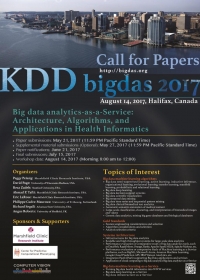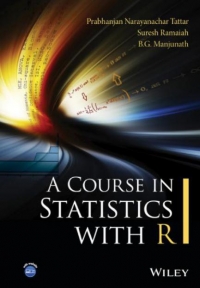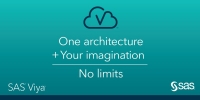This is a new and emerging area for the KDD community and we hope this workshop will bring together researchers and interested audiences to explore the open problems, applications, and future directions in Big data analytics-as- a-Service: Architecture, Algorithms, and Applications in Health Informatics. We invite submission of papers explaining innovative research studies on all aspects of big data analytics and its application in health informatics. Work-in-progress papers, demos, experimental studies, open-source developments, and visionary papers are also welcome. Suggested topics include (but are not limited to) the following with the focus of health informatics application area:
- Big data machine learning algorithms
- Big data semi-supervised learning, active learning, inductive inference, organizational learning, evolutional learning, transfer learning, manifold learning, probabilistic and relational learning
- Big data deep learning
- Big data decision support systems
- Big data scientific visualization
- Big temporal data mining
- Big data time series and sequential pattern mining
- Big data clinical/biomedical text analytics
- Automatic semantic annotation of medical content
- Large-scale classification, clustering, and interpretation of biomedical images and videos
- Genetic data analytics, mining big gene databases and biological databases
- Gold Standards
- Feature engineering considerations and selection
- Algorithm considerations and selection
- Analysis selection criteria
- Systems Architecture
- Infrastructures for big data analytics
- Scalable and high throughput systems for large-scale data analytics
- Performance evaluation or comparative study of big data analytics tools, such as DataMelt, RapidMiner, Orange, Rattle, Apache Spark MLlib, Apache Mahout, etc.
- Performance evaluation or comparative study of Machine Learning as a Service platforms, such as BigML, Microsoft Azure, Amazon Machine Learning, Google Cloud Prediction API, IBM Watson Analytics, etc.
- Integration PaaS (iPaaS) supporting Big Data applications and services
- Application of cloud computing to big data analytics
- Big data analytics-as-a-Service
- Big data machine learning-as-a-Service
- Turning big data health informatics into WWW services
- Big data deep learning-as-a-Service
- Big data infrastructure-as-a-Service
Important Dates:
Paper submissions: May 21, 2017 (11:59 PM Pacific Standard Time)
Supplemental material submissions (Optional): May 27, 2017 (11:59 PM Pacific Standard Time)
Paper notifications: June 21, 2017
Final submissions: July, 10, 2017
Workshop date: August 14, 2017 (Morning 8:00 am to 12:00)



